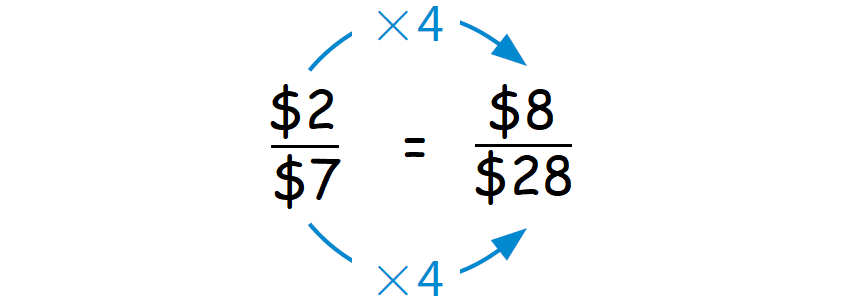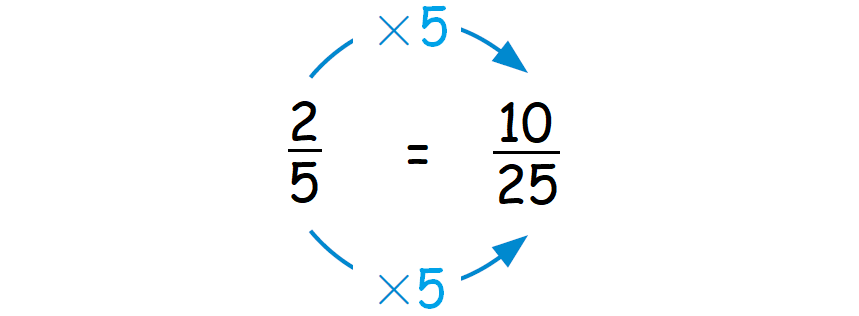USING RATIO REASONING TO SOLVE PROBLEMS
Ratio reasoning is nothing but a proportion which states that two ratios or rates are equivalent.
1/3 and 2/6 are equivalent ratios
1/3 = 2/6 is a proportion
Example 1 :
Sheldon and Leonard are partners in a business. Sheldon makes $2 in profits for every $5 that Leonard makes. If together they make a profit of $28 on the first item they sell, how much profit does Sheldon make ?
Solution :
Step 1 :
Given : Sheldon’s profit is $2 and Leonard's profit is $5.
Total profit = 2 + 5 = $7.
The ratio of Sheldon’s profit to the total profit is
$2/$7
Let S be the Sheldon's profit for the given total profit $28.
Then, we have

Step 2 :
Let us use ratio reasoning to find S.

Because $7 x 4 = $28, multiply $2 by 4.
Therefore, if they make a total profit of $28, then Sheldon makes a profit of $8.
Example 2 :
The members of the PTA are ordering pizza for a meeting. They plan to order 2 cheese pizzas for every 3 pepperoni pizzas they order. How many cheese pizzas will they order if they order a total of 25 pizzas ?
Solution :
Step 1 :
Given : 2 cheese pizzas for every 3 pepperoni pizzas.
Total profit = 2 + 3 = 5 pizzas
The ratio of cheese pizzas to total pizzas is
2/5
Let C be the number of cheese pizzas for the given total pizzas 25.
Then, we have

Step 2 :
Let us use ratio reasoning to find C.

Because 5 × 5 = 25, multiply 2 by 5.
Therefore, if they order a total of 25 pizzas, then they will order 10 cheese pizzas.
Example 3 :
In a fruit bowl, there are 2 oranges for every 3 apples. If there are 15 apples, how many oranges are there?
Solution :
Ratio between oranges to apples = 2 : 3
When number of apples = 15, let x be the number of oranges.
2 : 3 = x : 15
2/3 = x/15
Since we have fractions on both sides, we have to do cross multiplication.
2(15) = 3x
x = 30/3
x = 10
Example 4 :
Rupra is picking strawberries. For every 5 strawberries she puts in her basket, she eats 2. If she picks 28 strawberries, how many does she eat and how many does she put in the basket?
Solution :
For every 5 strawberries she puts, she eats 2. From this, for every 7 stawberries she picks, she puts 5 in basket and she eats 2.
Ratio between number of strawberries she picks to number of strawberries she eats,
= 7 : 2
Let x be the number of strawberries she eats when she picks 28.
7 : 2 = 28 : x
7/2 = 28/x
7x = 28(2)
x = 56/7
x = 8
Ratio between number of strawberries she picks to number of strawberries she puts,
= 7 : 5
Let y be the number of strawberries she puts when she picks 28.
7 : 5 = 28 : y
7/5 = 28/y
7y = 28(5)
y = 28(5) / 7
y = 4(5)
y = 20
Example 5 :
A bag of sweets contains red sweets and yellow sweets. The ratio of red to yellow is 3:7. If there are 40 sweets altogether, how many yellow sweets are there?
Solution :
Ratio between red to yellow sweets = 3 : 7
Let x be the number of yellow sweets.
Total number of sweets = 40
Then red sweets will be = 40 - x
(40 - x) : x = 3 : 7
(40 - x)/x = 3/7
7(40 - x) = 3x
280 - 7x = 3x
280 = 3x + 7x
280 = 10x
x = 280/10
x = 28
So, number of yellow sweets = 28
Number of red sweets = 40 - 28
= 12
Example 6 :
Jack has 30 sweets. He shares his sweets with his friend. When he gives his friend a sweet, he has 2 for himself. How many sweets do they each have?
Solution :
Ratio between number of sweets given to his friend and he has himself = 1 : 2
Number of sweets given to his friend = x
Number of sweets has himself = 2x
1x + 2x = 30
3x = 30
x = 30/3
x = 10
Number of sweets given to his friend = 10
Number of sweets has himself = 2(10) ==> 20
Example 7 :
In a field, there are some sheep and some goats. The ratio of sheep to goats is 3:1. If there are 3 goats, how many sheep are there?
Solution :
Ratio between sheeps to goats = 3 : 1
When number of goats = 3, then x be the number of sheeps.
x : 3 = 3 : 1
x/3 = 3/1
x = 9
So, the required number of sheeps is 9.
Example 8 :
Lucy has a necklace which has red beads and blue beads. For every red bead, there are four blue beads. There are 20 beads in total. How many of these are blue?
Solution :
Ratio between to red bead to blue bead = 1 : 4
Total number of beads = 20
Number of red bead = 1x
Number of blue bead = 4x
1x + 4x = 20
5x = 20
x = 20/5
x = 4
Number of red bead = 4
Number of blue bead = 4(4) ==> 16
So, number of blue bead is 16.
Example 9 :
Steffi is painting her house. She has calculated she needs 40 litres of paint in total. She has decided to mix pink paint. She will need 3 litres of white for every 2 litres of red. How many litres of each colour will she need to buy?
Solution :
Ratio between white colour to red colour = 3 : 2
Total quantity of paint = 40 liter
Quantity of white colour paint = 3x
Quantity of red colour paint = 2x
3x + 2x = 40
5x = 40
x = 40/5
x = 8
Quantity of white colour paint needs = 3(8) ==> 24 liter
Quantity of red colour paint needs = 2(8) ==> 16 liter
Example 10 :
In a pack of balloons, there are 3 different colours: red, blue and green. The ratio is 5:2:1 (red: blue: green). If there are 8 blue balloons in the pack, how many balloons are there in total?
Solution :
Ratio between red, blue and green balloons = 5 : 2 : 1
Total number of blue balloon = 2x
2x = 8
x = 8/2
x = 4
Number of red balloons = 5x ==> 5(4) ==> 20
Number of blue balloons = 2x ==> 2(4) ==> 8
Number of green balloons = 1x ==> 1(4) ==> 4
Total number of balloons = 20 + 8 + 4
= 32 balloons
Kindly mail your feedback to v4formath@gmail.com
We always appreciate your feedback.
©All rights reserved. onlinemath4all.com
Recent Articles
-
10 Hard SAT Math Questions (Part - 28)
Oct 14, 25 10:57 AM
10 Hard SAT Math Questions (Part - 28) -
SAT Math Questions and Answers
Oct 13, 25 01:09 PM
SAT Math Questions and Answers -
10 Hard SAT Math Questions (Part - 27)
Oct 13, 25 11:55 AM
10 Hard SAT Math Questions (Part - 27)
